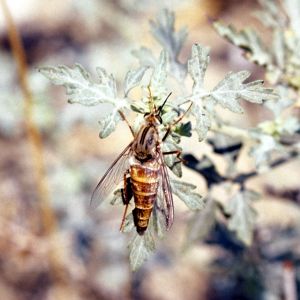DELHI SANDS FLOWERING-LOVING FLY
Rhaphiomidas terminatus abdominalis
The Delhi Sands Flower-Loving Fly is only known to occur in Riverside and San Bernardino Counties and is endemic to the Colton Dunes Ecosystem. They are only known from a few locations due to their habitat specificity. They are scarce due to habitat loss and degradation.
The characteristic feature of this species’ occupied habitat is fine wind-blown sandy soils, often wholly or partly within sand dunes stabilized by sparse native vegetation. Their diet is nectar from buckwheat and other plants.
Delhi Sands flower-loving fly undergoes a complete metamorphosis from egg to larva to pupa to adult. Oviposition (egg-laying) occurs within loose, sandy soils in the late summer. Eggs are placed 1 to 2 inches beneath the surface of the sand. Larval stages develop completely underground and emerge as adults from July through September.

| Life Stage/Activity Period | Jan | Feb | Mar | Apr | May | Jun | Jul | Aug | Sep | Oct | Nov | Dec |
|---|---|---|---|---|---|---|---|---|---|---|---|---|
| Adult Flight Season (breeding) |
See a map of the modeled species habitat distribution
The primary threat to the Delhi Sands flower-loving fly is loss of habitat, habitat degradation, and habitat fragmentation. Management is primarily habitat protection and enhancement.
How you can help: Try to avoid using pesticides and herbicides at your home. Residuals from these products enter natural areas and are detrimental to species such as the Delhi Sands Flower-loving Fly.
